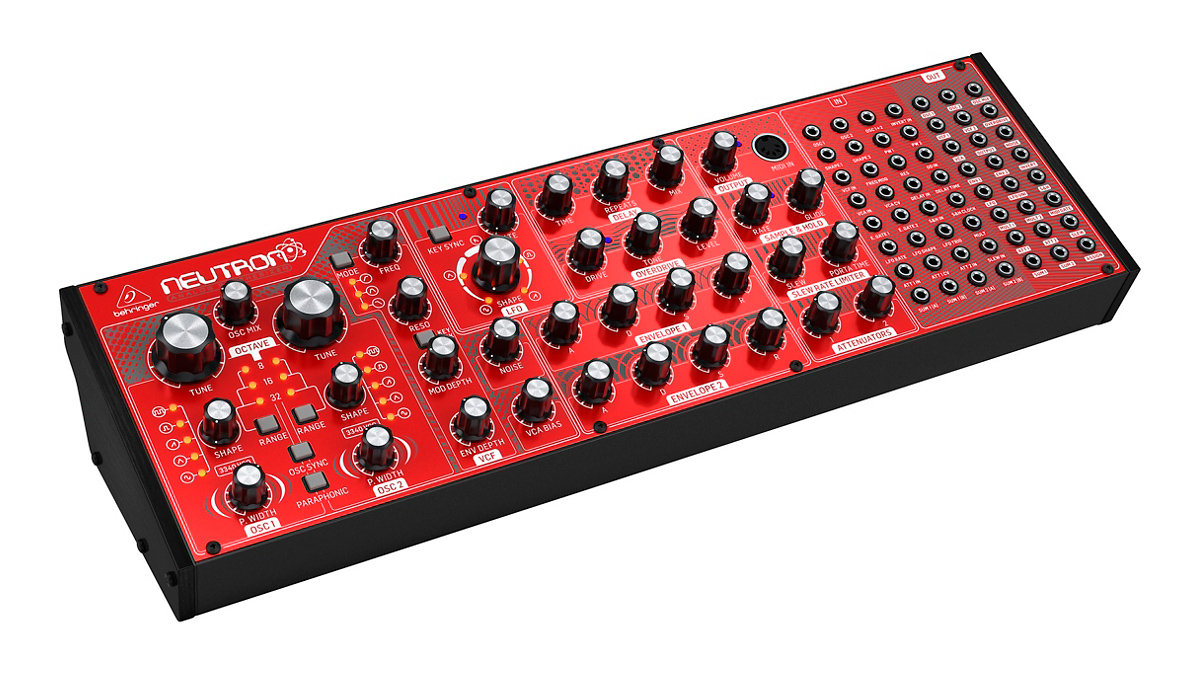Watch Dr Meaker create an entire track with the Behringer Neutron
The DnB veteran knocks up an atom-splitting DnB roller with nothing more than a a budget Behringer analogue synth
As we’ve opined on MusicRadar many times before, setting restrictions for yourself can really help inspire your music making. This could involve forcing yourself to work with a limited set of tools, restricting yourself to just a handful of track elements or writing within a confined time period. For his latest project, Bristol-based drum & bass musician Dr Meaker has pushed this idea to the limit, aiming to create a full DnB track with just a single synthesiser.
With two decades of experience in the game, DnB lynchpin Clive Meaker has carved out a reputation for himself amongst the UK scene, for both his infectious, bass-heavy productions and his live shows, which see Dr Meaker adapted into a full live band complete with drums, live bass, vocalists and a horn section.

For his track The Neutron, Clive stripped things right down though, creating every element of the release using a single Behringer Neutron synth. Originally pitched as an idea for a promotional video for Behringer, the promo aspect was eventually put on ice due to issues including supply chain delays, but Clive had already been inspired to write a full track.
“I decided, as I’m going to be sort of showing off the instrument, I may as well see if I can make a track myself in my own genre,” he explains. “I could kill two birds with one stone.
“I had an inkling I could do it. Back when I started using synths 20 years ago, I used to just try and make drums and all sorts of different sounds. So yeah, I set the challenge but I knew I could do it. And I did it. But it ended up working much better than even I thought it would.”
Not only did he pull it off, but the impressively polished results ended up signed for release on Symmetry Recordings. “It’s out there now as a single and climbing up the drum & bass charts. It’s getting supported by some of the biggest DJs across
the drum & bass scene. So it’s been a real sort of success story in that respect.”
We caught up with Clive in his Bristol studio to watch him break down The Neutron, as well as chat about gear, live performance and creative inspiration.
Want all the hottest music and gear news, reviews, deals, features and more, direct to your inbox? Sign up here.
How does the Neutron project compare to the way you usually work in the studio? Do you tend to put restrictions on your workflow a lot?
“Every track is different. I’ve worked with so many different approaches when making tracks. In the past, I’ve often started tracks with drums though, which tend to come from old funk breaks, sped up – which is the classic way that I work for drum & bass and jungle. But for the synthesis work – the bass, for example – I’ll often pull out one synth and just make all of it with that.
“A good example of that is a track I’ve got out on Jungle Cakes called MS20 Life. The drums have been made from all different sources and whatnot, but all of the bass sounds and all of the other synth sounds you hear in the track are all made on the MS-20. That’s actually my favourite synth of all time. I’ve got four different variations of it.”
Do those include Korg’s reissued MS-20 models?
“I’ve got the original mk1 here. I’ve then also got the original mk2, which is my main live synth as it sounds much rounder than the mk1 because of the filter chip. And then I’ve got a mini version, which is 86% of the size and analogue. That was really just for the studio because I could hook it up to MIDI, which is something I never had on the original.
The Korg MS-20 - that’s my performance instrument. That’s the thing that’s unique to me
“My mk2 went down about six months ago, and I was bricking it because I sent it off for repair and the person who repaired it didn’t know what they were doing. It came back broken still. I thought, ‘Oh my god, I’ve got shows coming up this summer – I need my MS-20 Mk2’. Otherwise I’d be done for, because that’s my performance instrument. That’s the thing that’s unique to me as a performer, which I haven’t seen anyone else do. So I went out and bought the new khaki green full-sized analogue version, which has got the switchable filter on the inside.
“I still haven’t opened that because, actually, I then sent off my Mk2 to another person who’s a specialist in repairing Korg synths and they got it working. So I’ve still got the khaki one in the box, in case I ever need it. If I don’t ever need it, then it’ll just hopefully become, like, a pension asset.”
Tell us a bit more about what you have in your live shows…
“Playing live is our main thing. That’s something that’s totally unique to Dr. Meaker, and I don’t know any other drum & bass bands in the world that do what we do as well as we do. We’ve just come back from Glastonbury last week. Absolutely brilliant show. And we’re looking forward to playing another 10 or 15 festivals this summer.
I don’t know any other drum & bass bands in the world that do what we do as well as we do
“What we do is we mix live electronic instruments, live acoustic instruments and soul vocals. That’s our main thing. We consist of myself on the keyboards, samplers and synths. Tom Wheeler on the drums. And we have Marcel Osborne on bass guitar. And three vocalists Celestine, Laurent and Tenisha. And then we have three or four horn players, Ben, Sam, Simon and Andrew.
“But the way we do it is we use a heavy backing track, which I produce and master. That’s already heavy, and almost like a record. Then we all play the live instruments and keyboards over that. So I leave big holes in the backing track, which we then play to.”

So you’re essentially adding live instrumentation over the top of the existing tracks?
“Yeah, it is like that. To make sure we have that heavy sound, I put all the drum breaks and everything that would be there on the record into the backing track. The same goes for the sub bass as well, because I find that you just can’t get that consistency in sub bass from a bass guitar.
“Every gig can be different too. Depending on the system and things like that. As a drum & bass band, we have to make sure we have heavy bass and drum elements. Everything else is mixed into that. The bass guitar is more for that low-mid range.
“We strip out the sub for when the drop comes. We’ve got pedals so we can switch the sub in and out for the intros, breakdowns and outros. Same with the drums. We have the sound engineer riding the subgroup faders to make sure that it’s mixed according to where we are in the song. So we end up with a perfect combination of live and backing track.”
Has it involved a fair amount of trial and error over the years?
“Absolutely, yeah. Our first gig as Dr Meaker was Ashton Court Festival, Bristol in 2004. So we’ve been running for 18 years now. And it’s been a long process, but we are a well oiled machine now. Thankfully, we started really young… so we’re still quite young [laughs].”


Future Music is the number one magazine for today's producers. Packed with technique and technology we'll help you make great new music. All-access artist interviews, in-depth gear reviews, essential production tutorials and much more. Every marvellous monthly edition features reliable reviews of the latest and greatest hardware and software technology and techniques, unparalleled advice, in-depth interviews, sensational free samples and so much more to improve the experience and outcome of your music-making.
